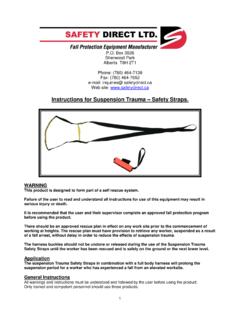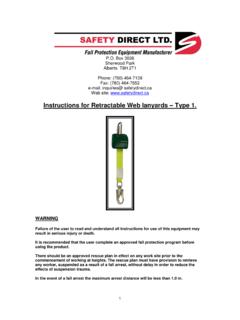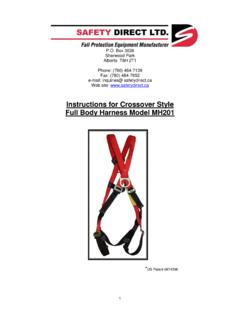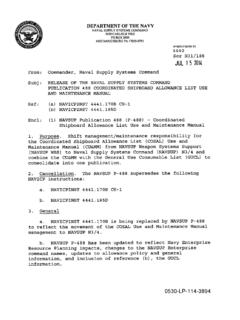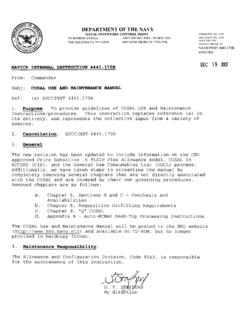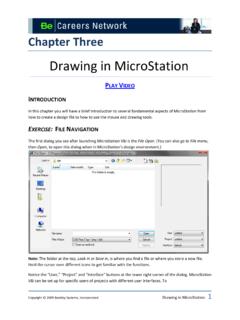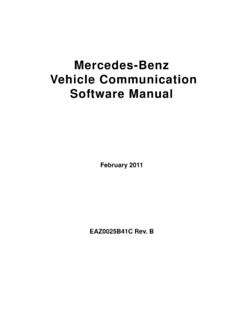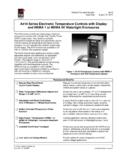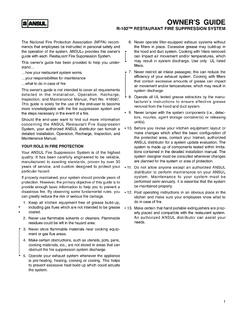Transcription of TYPE 1 SELF RETRACTING DEVICE (SRD) - Safety …
1 1 TYPE 1 self RETRACTING DEVICE (SRD) 7 ft ( m) 10 ft ( m) Snap hook RDW07A000 RDW10A000 Ladder hook RDW07A001 RDW10A001 Scaffold hook RDW07A002 RDW10A002 Loop RDW07A900 RDW10A900 Meets or exceeds standards and requirements established by: CSA ANSI OSHA Fall protection you can live with Safety DIRECT LTD. PO Box 3026 Sherwood Park Alberta Canada T8H 2T1 Phone 780 464 7139 Fax 780 464 7652 Toll Free 1 855 249 7112 Web 100 2210 Premier Way Sherwood Park Alberta Canada T8H 2L2 2 WARNING MESSAGES ARE INSERTED THROUGHOUT THE MANUAL AND HIGHLIGHT NECESSARY STEPS TO ENSURE SAFE WORKING CONDITIONS. READ THESE WARNINGS FIRST The SRD is only part of a total fall protection system and the use of compatible hardware and components is mandatory. The system components must meet federal, state, local or provincial regulations before being incorporated in a personal fall protection system. If you have any con-cerns or questions, please contact your distributor or Safety Direct.
2 Never clamp, knot or prevent the lifeline from RETRACTING or being taut. Avoid working above the anchorage level to avoid an increased free fall distance. It is imperative for the Safety and efficiency of operations that this manual be read and fully un-derstood by the worker before using any fall arrest system. ALL instructions contained herein must be carefully read and strictly followed. A fall could result in serious injury or death. Do not use any equipment unless properly trained. The limit of one person only per fall arrest system must always be observed. Do not let go of the webbing until it has completely rewound inside the SRD. Care should be taken to avoid contact with all sharp edges which could cut the webbing. Ensure adequate clearance exists in your fall path to prevent striking an object (Figure 3 and Figure 4). When the SRD is installed on a non-rigid anchor point, ensure the deflection of the system is taken into consideration within the calculation of the total clearance required.
3 For all assembly configurations: The anchoring to the structure must allow self -alignment of the SRD under the effect of the force exerted on the webbing. WARNING - A FALL COULD RESULT IN SERIOUS INJURY OR DEATH. DO NOT USE ANY EQUIPMENT UNLESS PROPERLY TRAINED. 3 SRD RETRACTABLE USE AND MAINTENANCE INSTRUCTIONS SRD Retractable Use and Maintenance Instructions .. 3 1. YOUR RESPONSIBILITY FOR COMPLIANCE .. 3 2. YOUR RESPONSIBILITY FOR INSPECTIONS .. 4 3. YOUR RESPONSIBILTY FOR TRAINING AND SUPERVISION .. 4 4. YOUR RESPONSIBILITY FOR COMPONETS OUTSIDE FALL ARREST SYSTEM .. 4 5. YOUR RESPONSIBILITY FOR RISK ASSESSMENT .. 4 6. DESCRIPTION .. 5 7. INSTALLATION .. 5 8. OPERATION .. 8 9. LIMITATION OF THE EQUIPMENT .. 9 10. INSPECTION .. 9 11. LABELLING .. 10 12. TROUBLESHOOTING .. 11 13. MAINTENANCE AND 11 14. WARRANTY INFORMATION .. 11 1. YOUR RESPONSIBILITY FOR COMPLIANCE It is the workers and their employers responsibility to strictly conform to the following warnings.
4 In all circumstances, if a fall arrest system, or any of its components are to be used by a worker not being directly supervised, you must provide a copy of these instructions and advise the worker that all instructions must be strictly followed. A fall could result in serious injury or death. Before using any fall arrest system, the worker and employer must become aware of all the re-quirements of federal, state, provincial and local Safety regulations applicable to the use of the fall arrest system and any component thereof. Components of a fall arrest system must be compatible and recommended by Safety Direct or the manufacturer of the DEVICE /system. Never use a fall arrest system or any components for any applications other than specified by the instructions supplied by the manufacturer of that DEVICE . Do not alter or adapt the equipment in any way. Any harness, lanyard, rope grab, self - RETRACTING lifeline or hardware that has been subjected to a fall, must be removed immediately from service.
5 The harness, lanyard, rope grab or hardware must be destroyed and replaced. The SRD must be sent to Safety Direct or authorized dealer for inspection and recertification. The combination of the user's weight, clothing and tools may not exceed 310 lbs. (140 kg). If this weight is exceeded the performance and Safety of the SRD cannot be guaranteed. This manual is intended to meet the Manufacturer's Instructions as required by CSA and ANSI and should be used as part of an employee training program as required by OSHA. Keep this guide available at all times for easy reference whenever required. Extra copies can be printed from the Safety Direct web site. 4 2. YOUR RESPONSIBILITY FOR INSPECTIONS Carefully take notice of all labels affixed to all components of the fall arrest system. Never use any equipment if the label normally fixed on fall arrest components is obscured or missing. Every time a fall arrest system is used, check the components of the system before proceeding.
6 They must be complete, compatible and in good working condition. Careful and regular inspection of the fall arrest system's installation is part of the Safety requirements. If you have any questions, contact Safety Direct. 3. YOUR RESPONSIBILTY FOR TRAINING AND SUPERVISION The state of health of the worker must allow them to withstand a possible fall arrest on the system being used. A worker must not be required to use a fall arrest system if that worker is not: mentally and physically fit for the purpose, especially at heights or in confined spaces; free from the influence of alcohol or drugs; competent for the job to be performed; familiar with the equipment and all applicable Safety rules, requirements or regulations; trained for working under the above requirements. Except for the operations described in this manual, the maintenance of Safety Direct equipment, as well as repair, must be exclusively done by authorized (written approval) Safety Direct dealers or by Safety Direct.
7 Never let a fall arrest system be managed or used by anyone other than authorized and assigned persons to the job. While out of operation, keep equipment installed or stored out of reach of un-authorized persons. Prior to putting the systems into operation, rescue procedures should be set up and workers should be trained in the event a fall occurs during a job. Such procedures must be set up by a qualified person or technical consultant according to work conditions. Every job must be placed under the control of a person having the required qualification and authority for checking that all the instructions prescribed by this manual are regularly and efficiently carried out. Contact Safety Direct for training information. 4. YOUR RESPONSIBILITY FOR COMPONETS OUTSIDE FALL ARREST SYSTEM Components of the installation other than the SRD must meet the requirements of the applicable regulations and legislation. They must be of the specified quality and must be assembled as a safe and efficient fall arrest system.
8 Anchor points are to have a minimal strength of 5,000 lbs. (22 kN), be sufficiently strong and in accordance with federal, state, provincial and local regulations. All requirements in strengths and resistance must be obtained with the necessary Safety coefficients. Prior to commencing the job, all calculations, design and subsequent work necessary to the above requirements must be made by a qualified person on the basis of technical information regarding the site. 5. YOUR RESPONSIBILITY FOR RISK ASSESSMENT For any job to be performed, consider and control the specific risks related to the nature of the job. After inspection, should you determine that a fall arrest system, or any component, is no longer to be used, take precautions to remove it so that it cannot be reused. It has to be discarded or disposed of, and precautions must be taken so that it cannot be reused. 5 During a rescue, the line or lines should be attached only to the dorsal D-ring and/or to both shoulder mounted D-rings of the harness if so equipped.
9 6. DESCRIPTION The SRD is a portable DEVICE supporting the following features: lightweight; easy to attach as the connector is kept in an upright position; high strength polymer housing has no sharp edges. Dyneema webbing with sewn in fall indicator The function of the SRD is to automatically stop a person s fall. The SRD is primarily intended to connect to a structure while the user is moving vertically directly under the SRD (Figure 1). The SRD can also be used in other positions as outlined in the Figures 5 and 6. The user is attached to the SRD whose length is automatically adjusted by a RETRACTING spring that activates a drum on which the webbing is coiled. In the event of a fall, the drum is locked under the effect of the centrifugal force caused by the acceleration of the falling mass attached to the webbing. The fall is stopped gradually by the friction of a disk braking system. Because the webbing is constantly tensioned between the user and the SRD, the user s free fall distance is held to a minimum by the disk braking system.
10 Always choose an SRD where the webbing length fits the expected distance travelled by the user. 7. INSTALLATION Anchoring to the structure An anchorage point is a secure point of attachment for lanyards, lifelines or self - RETRACTING lifelines. It has to be independent of the means of supporting the worker and must have been selected by a qualified person. The SRD must be connected to an anchorage point capable of supporting a minimum of 5,000 lbs. (22 kN) per attached worker. Consult governing regula-tions as revisions occur. Never use an anchorage point that will not allow the carabiner or connecting DEVICE to close. The anchor must be compatible with the carabiner or connecting DEVICE and must not cause a load to be applied to the gate. 6 Connecting to the harness It is mandatory to use a full body harness for fall arrest. Connect components on a safe surface where there is no risk of falling. The point at which the harness is attached must be below the SRD (Figure 2).


